BUS101: Business Environment Analysis of Shangri-La Sydney, Australia
VerifiedAdded on 2020/04/15
|19
|3603
|107
Report
AI Summary
This report provides a comprehensive analysis of the business environment of Shangri-La Sydney, a luxury hotel. It begins with an executive summary and table of contents, followed by an introduction to the business environment and its key components. The report then delves into an analysis of the external competitive environment using Porter's Five Forces model, assessing threats from new entrants, customer and supplier bargaining power, substitutes, and industry rivalry, with a focus on competitors like Four Seasons and Intercontinental Sydney. The report also analyzes the business environment from public perspectives, discussing social media strategies for customer engagement using platforms like Facebook, LinkedIn, and YouTube. Challenges are identified, including the need to cater to diverse customer needs and address financial and competitive pressures. The report includes a competitor analysis, highlighting customer focus, pricing strategies, employee satisfaction, and product diversification. Finally, the report concludes with a summary of key findings and recommendations for Shangri-La Sydney to maintain a competitive edge in the luxury hotel market.
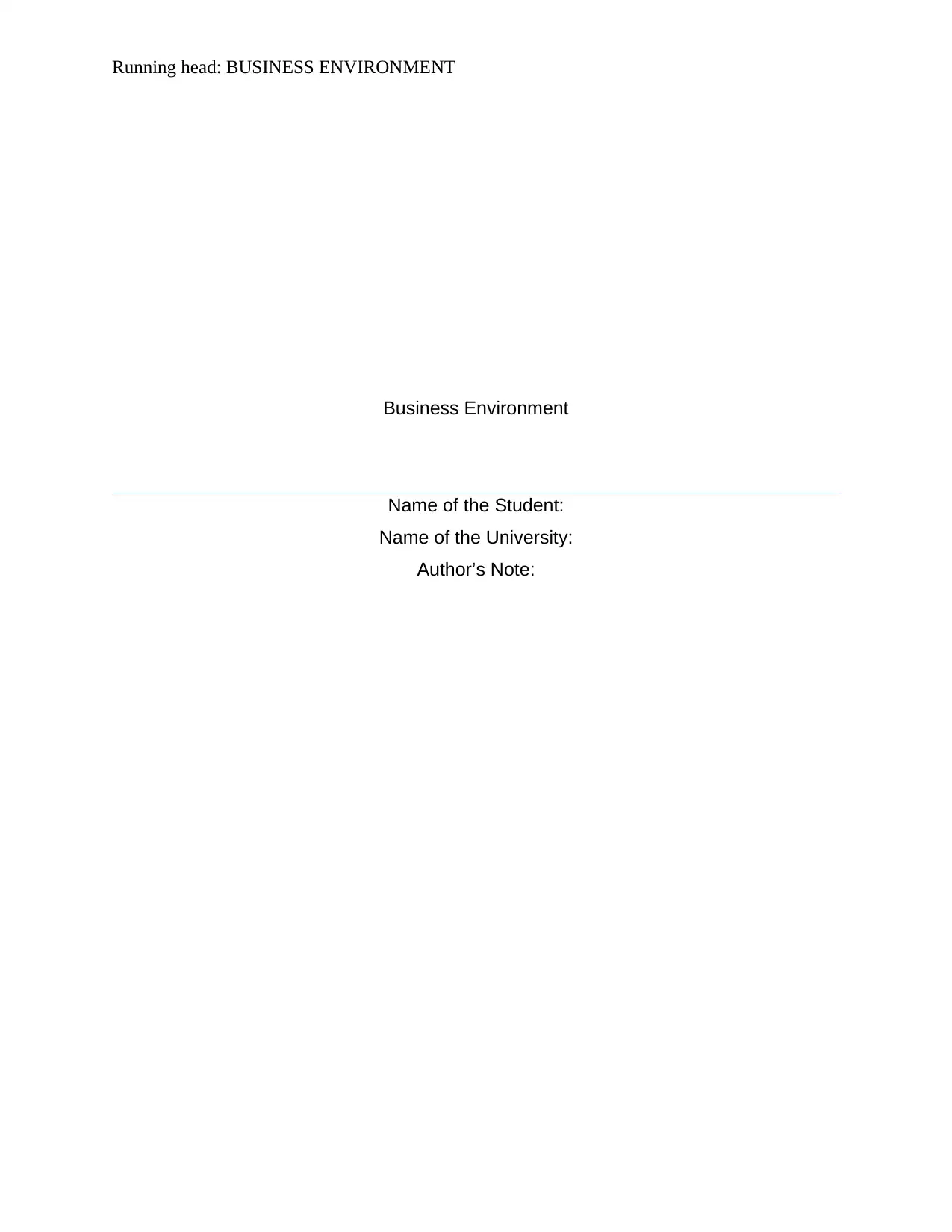
Running head: BUSINESS ENVIRONMENT
Business Environment
Name of the Student:
Name of the University:
Author’s Note:
Business Environment
Name of the Student:
Name of the University:
Author’s Note:
Paraphrase This Document
Need a fresh take? Get an instant paraphrase of this document with our AI Paraphraser

2BUSINESS ENVIRONMENT
Executive Summary
This present report highlights on business environment in the context of Shangri-La ,
which is a Sydney based luxury hotel. However, this hotel provides service offer to the
upper and middle class customers. However, they focus on the customer loyalty.
According to the Porter Five force analysis the major competitors of Shangri-La also
focus on the establishment of the customer loyalty. Threat of the substitutes is a big
barrier of their business thus; they need to make their business unique in the
international market. On the other hand, development of the customer oriented service
via social media will be effective for this organization to increase their sales revenue
generation. By using Facebook, Linkdin and You tube this organization can promote
their business. Apart from this it is crucial for this organization to keep confidentiality of
the information while using such digital tools.
Executive Summary
This present report highlights on business environment in the context of Shangri-La ,
which is a Sydney based luxury hotel. However, this hotel provides service offer to the
upper and middle class customers. However, they focus on the customer loyalty.
According to the Porter Five force analysis the major competitors of Shangri-La also
focus on the establishment of the customer loyalty. Threat of the substitutes is a big
barrier of their business thus; they need to make their business unique in the
international market. On the other hand, development of the customer oriented service
via social media will be effective for this organization to increase their sales revenue
generation. By using Facebook, Linkdin and You tube this organization can promote
their business. Apart from this it is crucial for this organization to keep confidentiality of
the information while using such digital tools.
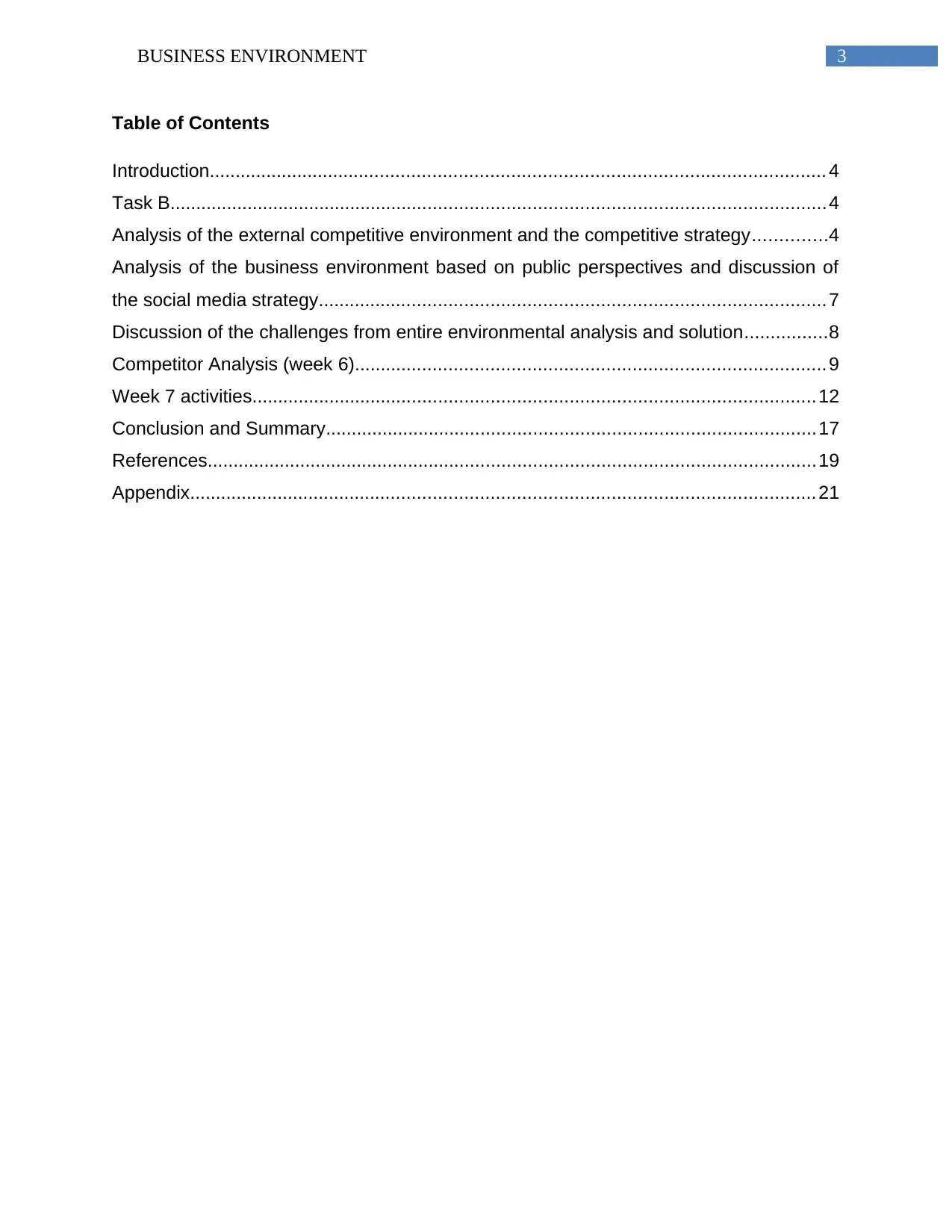
3BUSINESS ENVIRONMENT
Table of Contents
Introduction...................................................................................................................... 4
Task B..............................................................................................................................4
Analysis of the external competitive environment and the competitive strategy..............4
Analysis of the business environment based on public perspectives and discussion of
the social media strategy................................................................................................. 7
Discussion of the challenges from entire environmental analysis and solution................8
Competitor Analysis (week 6).......................................................................................... 9
Week 7 activities............................................................................................................ 12
Conclusion and Summary..............................................................................................17
References.....................................................................................................................19
Appendix........................................................................................................................ 21
Table of Contents
Introduction...................................................................................................................... 4
Task B..............................................................................................................................4
Analysis of the external competitive environment and the competitive strategy..............4
Analysis of the business environment based on public perspectives and discussion of
the social media strategy................................................................................................. 7
Discussion of the challenges from entire environmental analysis and solution................8
Competitor Analysis (week 6).......................................................................................... 9
Week 7 activities............................................................................................................ 12
Conclusion and Summary..............................................................................................17
References.....................................................................................................................19
Appendix........................................................................................................................ 21
⊘ This is a preview!⊘
Do you want full access?
Subscribe today to unlock all pages.

Trusted by 1+ million students worldwide
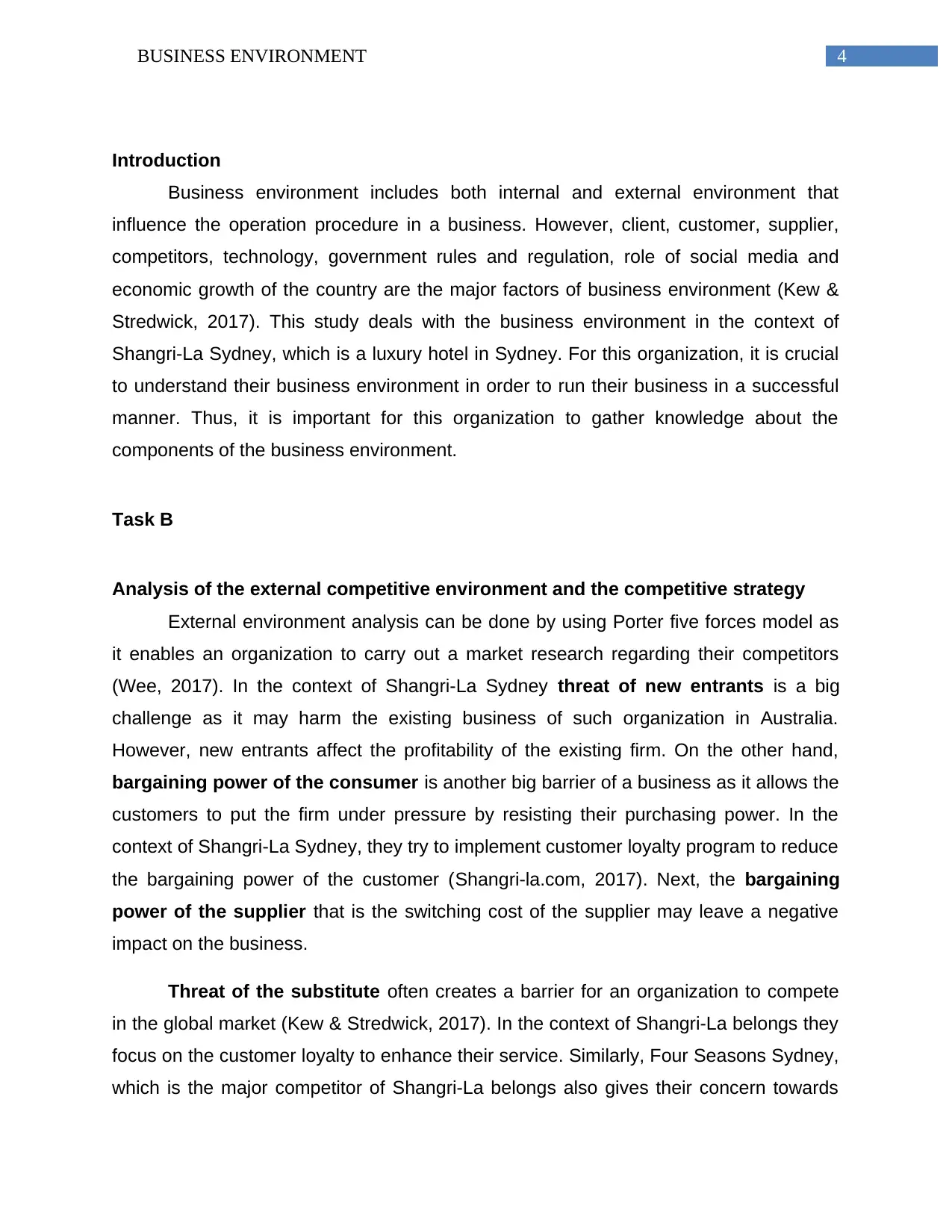
4BUSINESS ENVIRONMENT
Introduction
Business environment includes both internal and external environment that
influence the operation procedure in a business. However, client, customer, supplier,
competitors, technology, government rules and regulation, role of social media and
economic growth of the country are the major factors of business environment (Kew &
Stredwick, 2017). This study deals with the business environment in the context of
Shangri-La Sydney, which is a luxury hotel in Sydney. For this organization, it is crucial
to understand their business environment in order to run their business in a successful
manner. Thus, it is important for this organization to gather knowledge about the
components of the business environment.
Task B
Analysis of the external competitive environment and the competitive strategy
External environment analysis can be done by using Porter five forces model as
it enables an organization to carry out a market research regarding their competitors
(Wee, 2017). In the context of Shangri-La Sydney threat of new entrants is a big
challenge as it may harm the existing business of such organization in Australia.
However, new entrants affect the profitability of the existing firm. On the other hand,
bargaining power of the consumer is another big barrier of a business as it allows the
customers to put the firm under pressure by resisting their purchasing power. In the
context of Shangri-La Sydney, they try to implement customer loyalty program to reduce
the bargaining power of the customer (Shangri-la.com, 2017). Next, the bargaining
power of the supplier that is the switching cost of the supplier may leave a negative
impact on the business.
Threat of the substitute often creates a barrier for an organization to compete
in the global market (Kew & Stredwick, 2017). In the context of Shangri-La belongs they
focus on the customer loyalty to enhance their service. Similarly, Four Seasons Sydney,
which is the major competitor of Shangri-La belongs also gives their concern towards
Introduction
Business environment includes both internal and external environment that
influence the operation procedure in a business. However, client, customer, supplier,
competitors, technology, government rules and regulation, role of social media and
economic growth of the country are the major factors of business environment (Kew &
Stredwick, 2017). This study deals with the business environment in the context of
Shangri-La Sydney, which is a luxury hotel in Sydney. For this organization, it is crucial
to understand their business environment in order to run their business in a successful
manner. Thus, it is important for this organization to gather knowledge about the
components of the business environment.
Task B
Analysis of the external competitive environment and the competitive strategy
External environment analysis can be done by using Porter five forces model as
it enables an organization to carry out a market research regarding their competitors
(Wee, 2017). In the context of Shangri-La Sydney threat of new entrants is a big
challenge as it may harm the existing business of such organization in Australia.
However, new entrants affect the profitability of the existing firm. On the other hand,
bargaining power of the consumer is another big barrier of a business as it allows the
customers to put the firm under pressure by resisting their purchasing power. In the
context of Shangri-La Sydney, they try to implement customer loyalty program to reduce
the bargaining power of the customer (Shangri-la.com, 2017). Next, the bargaining
power of the supplier that is the switching cost of the supplier may leave a negative
impact on the business.
Threat of the substitute often creates a barrier for an organization to compete
in the global market (Kew & Stredwick, 2017). In the context of Shangri-La belongs they
focus on the customer loyalty to enhance their service. Similarly, Four Seasons Sydney,
which is the major competitor of Shangri-La belongs also gives their concern towards
Paraphrase This Document
Need a fresh take? Get an instant paraphrase of this document with our AI Paraphraser
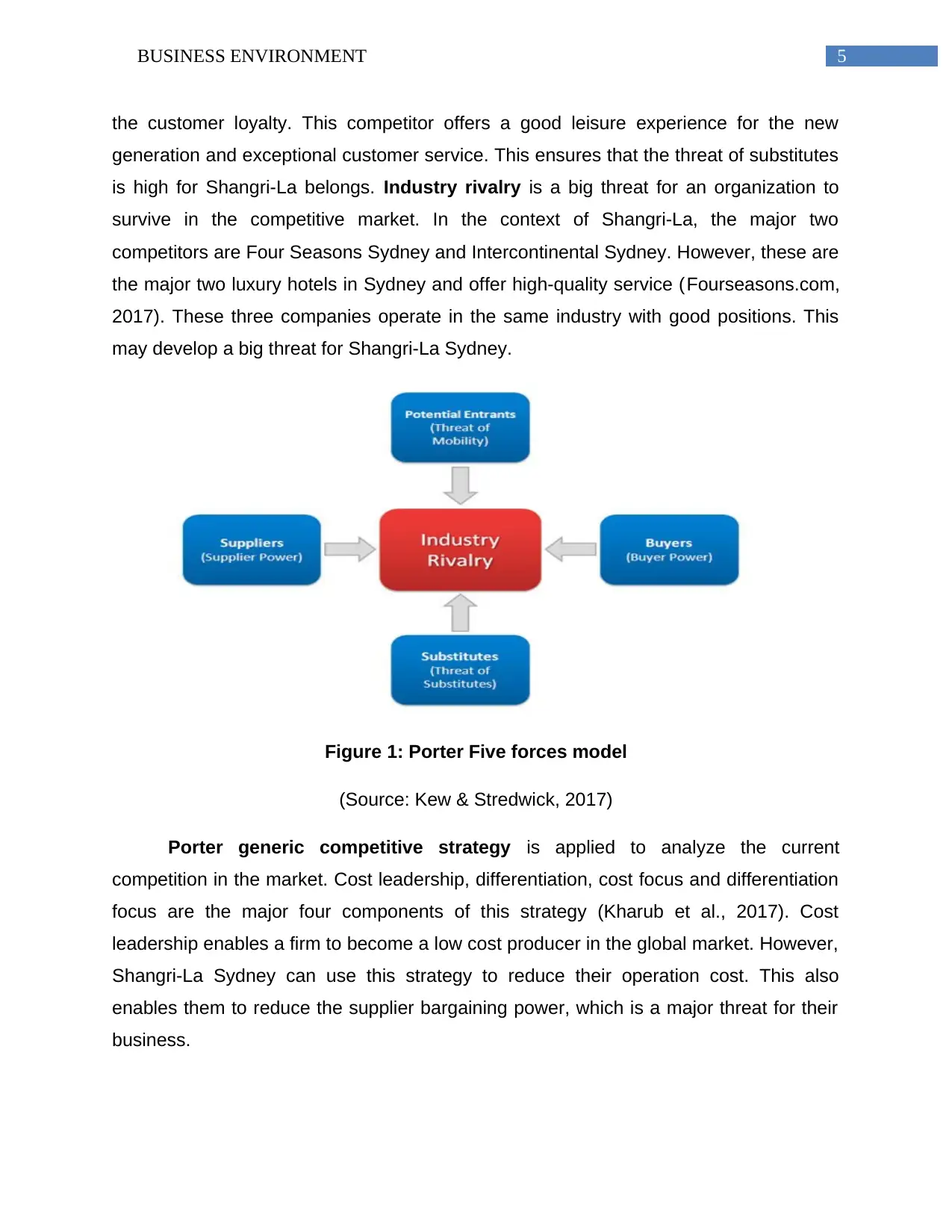
5BUSINESS ENVIRONMENT
the customer loyalty. This competitor offers a good leisure experience for the new
generation and exceptional customer service. This ensures that the threat of substitutes
is high for Shangri-La belongs. Industry rivalry is a big threat for an organization to
survive in the competitive market. In the context of Shangri-La, the major two
competitors are Four Seasons Sydney and Intercontinental Sydney. However, these are
the major two luxury hotels in Sydney and offer high-quality service (Fourseasons.com,
2017). These three companies operate in the same industry with good positions. This
may develop a big threat for Shangri-La Sydney.
Figure 1: Porter Five forces model
(Source: Kew & Stredwick, 2017)
Porter generic competitive strategy is applied to analyze the current
competition in the market. Cost leadership, differentiation, cost focus and differentiation
focus are the major four components of this strategy (Kharub et al., 2017). Cost
leadership enables a firm to become a low cost producer in the global market. However,
Shangri-La Sydney can use this strategy to reduce their operation cost. This also
enables them to reduce the supplier bargaining power, which is a major threat for their
business.
the customer loyalty. This competitor offers a good leisure experience for the new
generation and exceptional customer service. This ensures that the threat of substitutes
is high for Shangri-La belongs. Industry rivalry is a big threat for an organization to
survive in the competitive market. In the context of Shangri-La, the major two
competitors are Four Seasons Sydney and Intercontinental Sydney. However, these are
the major two luxury hotels in Sydney and offer high-quality service (Fourseasons.com,
2017). These three companies operate in the same industry with good positions. This
may develop a big threat for Shangri-La Sydney.
Figure 1: Porter Five forces model
(Source: Kew & Stredwick, 2017)
Porter generic competitive strategy is applied to analyze the current
competition in the market. Cost leadership, differentiation, cost focus and differentiation
focus are the major four components of this strategy (Kharub et al., 2017). Cost
leadership enables a firm to become a low cost producer in the global market. However,
Shangri-La Sydney can use this strategy to reduce their operation cost. This also
enables them to reduce the supplier bargaining power, which is a major threat for their
business.
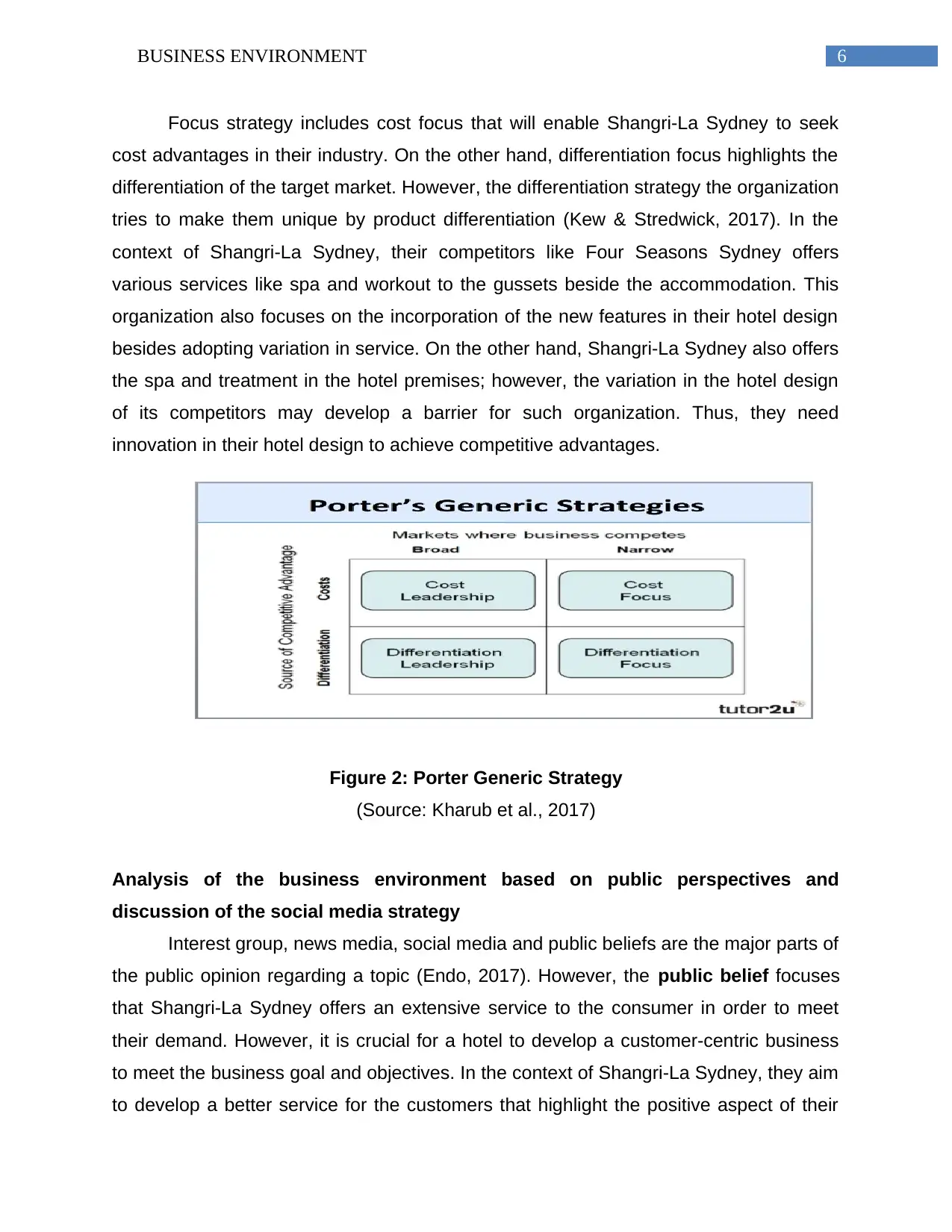
6BUSINESS ENVIRONMENT
Focus strategy includes cost focus that will enable Shangri-La Sydney to seek
cost advantages in their industry. On the other hand, differentiation focus highlights the
differentiation of the target market. However, the differentiation strategy the organization
tries to make them unique by product differentiation (Kew & Stredwick, 2017). In the
context of Shangri-La Sydney, their competitors like Four Seasons Sydney offers
various services like spa and workout to the gussets beside the accommodation. This
organization also focuses on the incorporation of the new features in their hotel design
besides adopting variation in service. On the other hand, Shangri-La Sydney also offers
the spa and treatment in the hotel premises; however, the variation in the hotel design
of its competitors may develop a barrier for such organization. Thus, they need
innovation in their hotel design to achieve competitive advantages.
Figure 2: Porter Generic Strategy
(Source: Kharub et al., 2017)
Analysis of the business environment based on public perspectives and
discussion of the social media strategy
Interest group, news media, social media and public beliefs are the major parts of
the public opinion regarding a topic (Endo, 2017). However, the public belief focuses
that Shangri-La Sydney offers an extensive service to the consumer in order to meet
their demand. However, it is crucial for a hotel to develop a customer-centric business
to meet the business goal and objectives. In the context of Shangri-La Sydney, they aim
to develop a better service for the customers that highlight the positive aspect of their
Focus strategy includes cost focus that will enable Shangri-La Sydney to seek
cost advantages in their industry. On the other hand, differentiation focus highlights the
differentiation of the target market. However, the differentiation strategy the organization
tries to make them unique by product differentiation (Kew & Stredwick, 2017). In the
context of Shangri-La Sydney, their competitors like Four Seasons Sydney offers
various services like spa and workout to the gussets beside the accommodation. This
organization also focuses on the incorporation of the new features in their hotel design
besides adopting variation in service. On the other hand, Shangri-La Sydney also offers
the spa and treatment in the hotel premises; however, the variation in the hotel design
of its competitors may develop a barrier for such organization. Thus, they need
innovation in their hotel design to achieve competitive advantages.
Figure 2: Porter Generic Strategy
(Source: Kharub et al., 2017)
Analysis of the business environment based on public perspectives and
discussion of the social media strategy
Interest group, news media, social media and public beliefs are the major parts of
the public opinion regarding a topic (Endo, 2017). However, the public belief focuses
that Shangri-La Sydney offers an extensive service to the consumer in order to meet
their demand. However, it is crucial for a hotel to develop a customer-centric business
to meet the business goal and objectives. In the context of Shangri-La Sydney, they aim
to develop a better service for the customers that highlight the positive aspect of their
⊘ This is a preview!⊘
Do you want full access?
Subscribe today to unlock all pages.

Trusted by 1+ million students worldwide
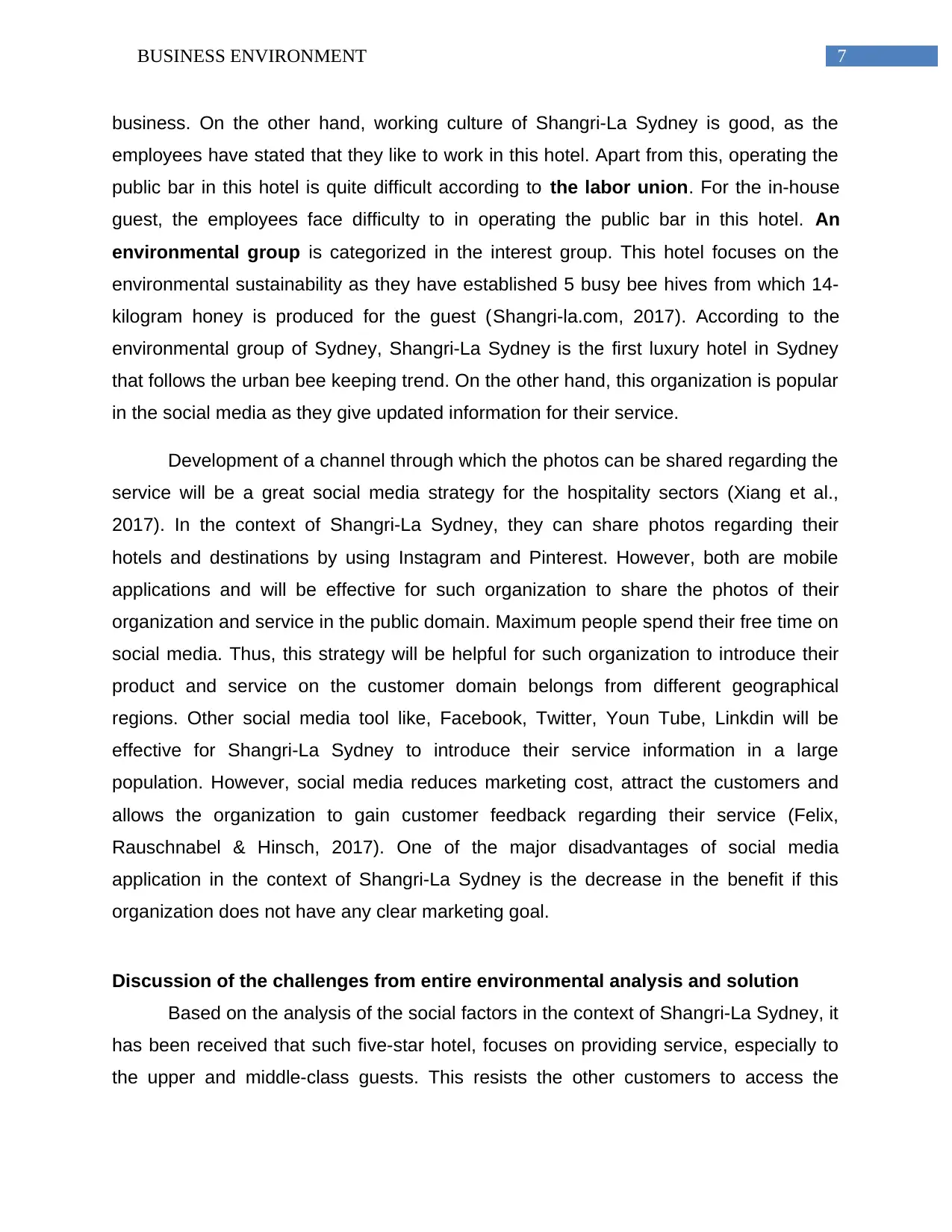
7BUSINESS ENVIRONMENT
business. On the other hand, working culture of Shangri-La Sydney is good, as the
employees have stated that they like to work in this hotel. Apart from this, operating the
public bar in this hotel is quite difficult according to the labor union. For the in-house
guest, the employees face difficulty to in operating the public bar in this hotel. An
environmental group is categorized in the interest group. This hotel focuses on the
environmental sustainability as they have established 5 busy bee hives from which 14-
kilogram honey is produced for the guest (Shangri-la.com, 2017). According to the
environmental group of Sydney, Shangri-La Sydney is the first luxury hotel in Sydney
that follows the urban bee keeping trend. On the other hand, this organization is popular
in the social media as they give updated information for their service.
Development of a channel through which the photos can be shared regarding the
service will be a great social media strategy for the hospitality sectors (Xiang et al.,
2017). In the context of Shangri-La Sydney, they can share photos regarding their
hotels and destinations by using Instagram and Pinterest. However, both are mobile
applications and will be effective for such organization to share the photos of their
organization and service in the public domain. Maximum people spend their free time on
social media. Thus, this strategy will be helpful for such organization to introduce their
product and service on the customer domain belongs from different geographical
regions. Other social media tool like, Facebook, Twitter, Youn Tube, Linkdin will be
effective for Shangri-La Sydney to introduce their service information in a large
population. However, social media reduces marketing cost, attract the customers and
allows the organization to gain customer feedback regarding their service (Felix,
Rauschnabel & Hinsch, 2017). One of the major disadvantages of social media
application in the context of Shangri-La Sydney is the decrease in the benefit if this
organization does not have any clear marketing goal.
Discussion of the challenges from entire environmental analysis and solution
Based on the analysis of the social factors in the context of Shangri-La Sydney, it
has been received that such five-star hotel, focuses on providing service, especially to
the upper and middle-class guests. This resists the other customers to access the
business. On the other hand, working culture of Shangri-La Sydney is good, as the
employees have stated that they like to work in this hotel. Apart from this, operating the
public bar in this hotel is quite difficult according to the labor union. For the in-house
guest, the employees face difficulty to in operating the public bar in this hotel. An
environmental group is categorized in the interest group. This hotel focuses on the
environmental sustainability as they have established 5 busy bee hives from which 14-
kilogram honey is produced for the guest (Shangri-la.com, 2017). According to the
environmental group of Sydney, Shangri-La Sydney is the first luxury hotel in Sydney
that follows the urban bee keeping trend. On the other hand, this organization is popular
in the social media as they give updated information for their service.
Development of a channel through which the photos can be shared regarding the
service will be a great social media strategy for the hospitality sectors (Xiang et al.,
2017). In the context of Shangri-La Sydney, they can share photos regarding their
hotels and destinations by using Instagram and Pinterest. However, both are mobile
applications and will be effective for such organization to share the photos of their
organization and service in the public domain. Maximum people spend their free time on
social media. Thus, this strategy will be helpful for such organization to introduce their
product and service on the customer domain belongs from different geographical
regions. Other social media tool like, Facebook, Twitter, Youn Tube, Linkdin will be
effective for Shangri-La Sydney to introduce their service information in a large
population. However, social media reduces marketing cost, attract the customers and
allows the organization to gain customer feedback regarding their service (Felix,
Rauschnabel & Hinsch, 2017). One of the major disadvantages of social media
application in the context of Shangri-La Sydney is the decrease in the benefit if this
organization does not have any clear marketing goal.
Discussion of the challenges from entire environmental analysis and solution
Based on the analysis of the social factors in the context of Shangri-La Sydney, it
has been received that such five-star hotel, focuses on providing service, especially to
the upper and middle-class guests. This resists the other customers to access the
Paraphrase This Document
Need a fresh take? Get an instant paraphrase of this document with our AI Paraphraser
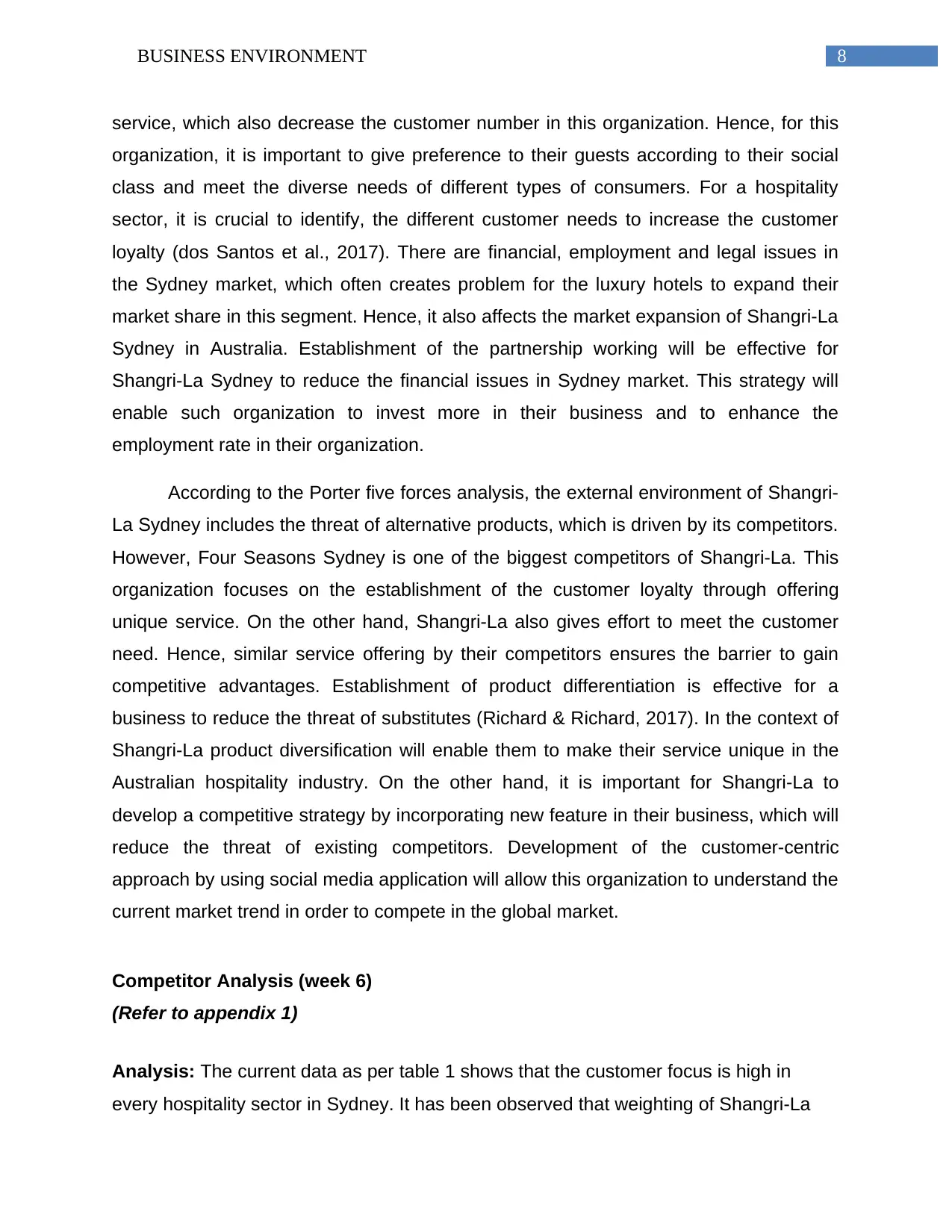
8BUSINESS ENVIRONMENT
service, which also decrease the customer number in this organization. Hence, for this
organization, it is important to give preference to their guests according to their social
class and meet the diverse needs of different types of consumers. For a hospitality
sector, it is crucial to identify, the different customer needs to increase the customer
loyalty (dos Santos et al., 2017). There are financial, employment and legal issues in
the Sydney market, which often creates problem for the luxury hotels to expand their
market share in this segment. Hence, it also affects the market expansion of Shangri-La
Sydney in Australia. Establishment of the partnership working will be effective for
Shangri-La Sydney to reduce the financial issues in Sydney market. This strategy will
enable such organization to invest more in their business and to enhance the
employment rate in their organization.
According to the Porter five forces analysis, the external environment of Shangri-
La Sydney includes the threat of alternative products, which is driven by its competitors.
However, Four Seasons Sydney is one of the biggest competitors of Shangri-La. This
organization focuses on the establishment of the customer loyalty through offering
unique service. On the other hand, Shangri-La also gives effort to meet the customer
need. Hence, similar service offering by their competitors ensures the barrier to gain
competitive advantages. Establishment of product differentiation is effective for a
business to reduce the threat of substitutes (Richard & Richard, 2017). In the context of
Shangri-La product diversification will enable them to make their service unique in the
Australian hospitality industry. On the other hand, it is important for Shangri-La to
develop a competitive strategy by incorporating new feature in their business, which will
reduce the threat of existing competitors. Development of the customer-centric
approach by using social media application will allow this organization to understand the
current market trend in order to compete in the global market.
Competitor Analysis (week 6)
(Refer to appendix 1)
Analysis: The current data as per table 1 shows that the customer focus is high in
every hospitality sector in Sydney. It has been observed that weighting of Shangri-La
service, which also decrease the customer number in this organization. Hence, for this
organization, it is important to give preference to their guests according to their social
class and meet the diverse needs of different types of consumers. For a hospitality
sector, it is crucial to identify, the different customer needs to increase the customer
loyalty (dos Santos et al., 2017). There are financial, employment and legal issues in
the Sydney market, which often creates problem for the luxury hotels to expand their
market share in this segment. Hence, it also affects the market expansion of Shangri-La
Sydney in Australia. Establishment of the partnership working will be effective for
Shangri-La Sydney to reduce the financial issues in Sydney market. This strategy will
enable such organization to invest more in their business and to enhance the
employment rate in their organization.
According to the Porter five forces analysis, the external environment of Shangri-
La Sydney includes the threat of alternative products, which is driven by its competitors.
However, Four Seasons Sydney is one of the biggest competitors of Shangri-La. This
organization focuses on the establishment of the customer loyalty through offering
unique service. On the other hand, Shangri-La also gives effort to meet the customer
need. Hence, similar service offering by their competitors ensures the barrier to gain
competitive advantages. Establishment of product differentiation is effective for a
business to reduce the threat of substitutes (Richard & Richard, 2017). In the context of
Shangri-La product diversification will enable them to make their service unique in the
Australian hospitality industry. On the other hand, it is important for Shangri-La to
develop a competitive strategy by incorporating new feature in their business, which will
reduce the threat of existing competitors. Development of the customer-centric
approach by using social media application will allow this organization to understand the
current market trend in order to compete in the global market.
Competitor Analysis (week 6)
(Refer to appendix 1)
Analysis: The current data as per table 1 shows that the customer focus is high in
every hospitality sector in Sydney. It has been observed that weighting of Shangri-La
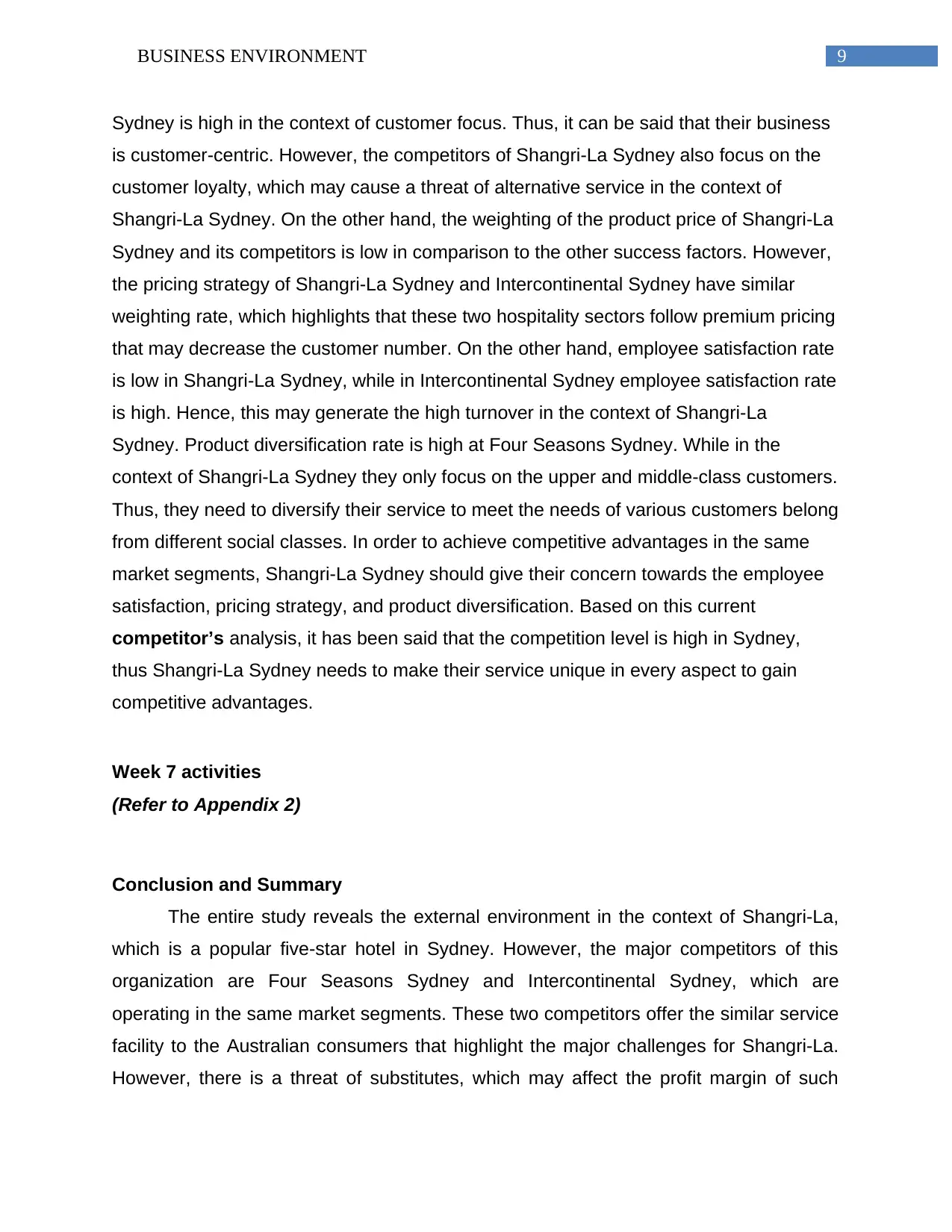
9BUSINESS ENVIRONMENT
Sydney is high in the context of customer focus. Thus, it can be said that their business
is customer-centric. However, the competitors of Shangri-La Sydney also focus on the
customer loyalty, which may cause a threat of alternative service in the context of
Shangri-La Sydney. On the other hand, the weighting of the product price of Shangri-La
Sydney and its competitors is low in comparison to the other success factors. However,
the pricing strategy of Shangri-La Sydney and Intercontinental Sydney have similar
weighting rate, which highlights that these two hospitality sectors follow premium pricing
that may decrease the customer number. On the other hand, employee satisfaction rate
is low in Shangri-La Sydney, while in Intercontinental Sydney employee satisfaction rate
is high. Hence, this may generate the high turnover in the context of Shangri-La
Sydney. Product diversification rate is high at Four Seasons Sydney. While in the
context of Shangri-La Sydney they only focus on the upper and middle-class customers.
Thus, they need to diversify their service to meet the needs of various customers belong
from different social classes. In order to achieve competitive advantages in the same
market segments, Shangri-La Sydney should give their concern towards the employee
satisfaction, pricing strategy, and product diversification. Based on this current
competitor’s analysis, it has been said that the competition level is high in Sydney,
thus Shangri-La Sydney needs to make their service unique in every aspect to gain
competitive advantages.
Week 7 activities
(Refer to Appendix 2)
Conclusion and Summary
The entire study reveals the external environment in the context of Shangri-La,
which is a popular five-star hotel in Sydney. However, the major competitors of this
organization are Four Seasons Sydney and Intercontinental Sydney, which are
operating in the same market segments. These two competitors offer the similar service
facility to the Australian consumers that highlight the major challenges for Shangri-La.
However, there is a threat of substitutes, which may affect the profit margin of such
Sydney is high in the context of customer focus. Thus, it can be said that their business
is customer-centric. However, the competitors of Shangri-La Sydney also focus on the
customer loyalty, which may cause a threat of alternative service in the context of
Shangri-La Sydney. On the other hand, the weighting of the product price of Shangri-La
Sydney and its competitors is low in comparison to the other success factors. However,
the pricing strategy of Shangri-La Sydney and Intercontinental Sydney have similar
weighting rate, which highlights that these two hospitality sectors follow premium pricing
that may decrease the customer number. On the other hand, employee satisfaction rate
is low in Shangri-La Sydney, while in Intercontinental Sydney employee satisfaction rate
is high. Hence, this may generate the high turnover in the context of Shangri-La
Sydney. Product diversification rate is high at Four Seasons Sydney. While in the
context of Shangri-La Sydney they only focus on the upper and middle-class customers.
Thus, they need to diversify their service to meet the needs of various customers belong
from different social classes. In order to achieve competitive advantages in the same
market segments, Shangri-La Sydney should give their concern towards the employee
satisfaction, pricing strategy, and product diversification. Based on this current
competitor’s analysis, it has been said that the competition level is high in Sydney,
thus Shangri-La Sydney needs to make their service unique in every aspect to gain
competitive advantages.
Week 7 activities
(Refer to Appendix 2)
Conclusion and Summary
The entire study reveals the external environment in the context of Shangri-La,
which is a popular five-star hotel in Sydney. However, the major competitors of this
organization are Four Seasons Sydney and Intercontinental Sydney, which are
operating in the same market segments. These two competitors offer the similar service
facility to the Australian consumers that highlight the major challenges for Shangri-La.
However, there is a threat of substitutes, which may affect the profit margin of such
⊘ This is a preview!⊘
Do you want full access?
Subscribe today to unlock all pages.

Trusted by 1+ million students worldwide
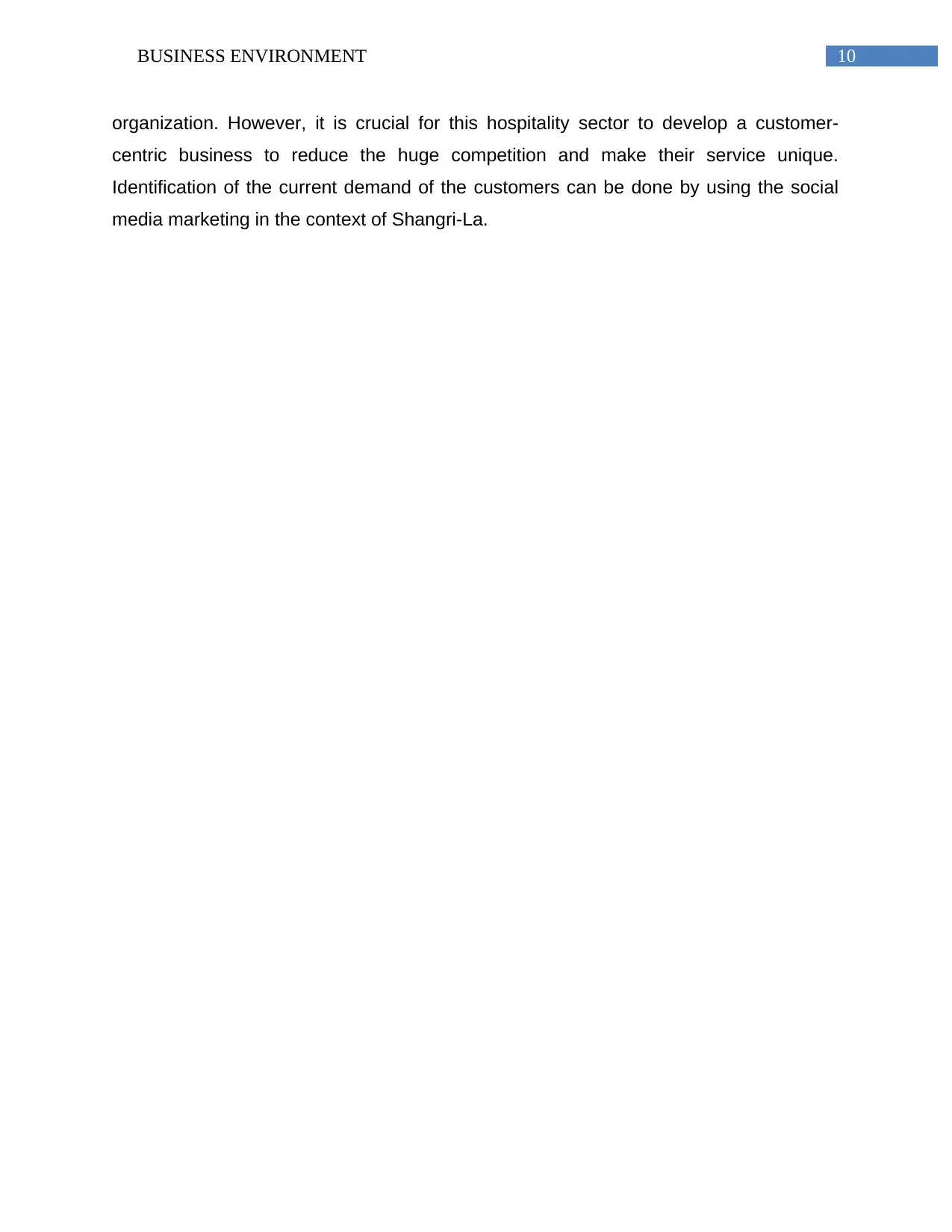
10BUSINESS ENVIRONMENT
organization. However, it is crucial for this hospitality sector to develop a customer-
centric business to reduce the huge competition and make their service unique.
Identification of the current demand of the customers can be done by using the social
media marketing in the context of Shangri-La.
organization. However, it is crucial for this hospitality sector to develop a customer-
centric business to reduce the huge competition and make their service unique.
Identification of the current demand of the customers can be done by using the social
media marketing in the context of Shangri-La.
Paraphrase This Document
Need a fresh take? Get an instant paraphrase of this document with our AI Paraphraser
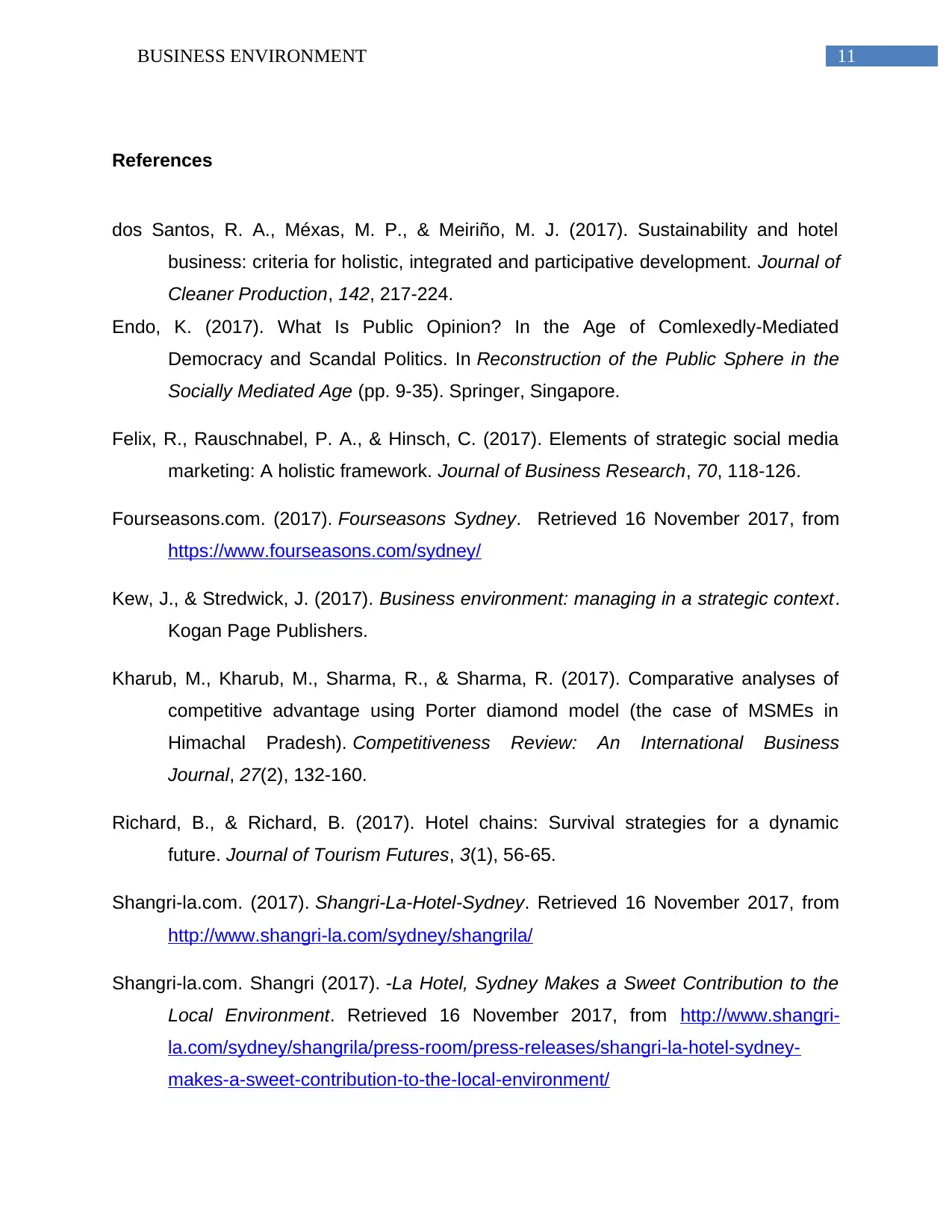
11BUSINESS ENVIRONMENT
References
dos Santos, R. A., Méxas, M. P., & Meiriño, M. J. (2017). Sustainability and hotel
business: criteria for holistic, integrated and participative development. Journal of
Cleaner Production, 142, 217-224.
Endo, K. (2017). What Is Public Opinion? In the Age of Comlexedly-Mediated
Democracy and Scandal Politics. In Reconstruction of the Public Sphere in the
Socially Mediated Age (pp. 9-35). Springer, Singapore.
Felix, R., Rauschnabel, P. A., & Hinsch, C. (2017). Elements of strategic social media
marketing: A holistic framework. Journal of Business Research, 70, 118-126.
Fourseasons.com. (2017). Fourseasons Sydney. Retrieved 16 November 2017, from
https://www.fourseasons.com/sydney/
Kew, J., & Stredwick, J. (2017). Business environment: managing in a strategic context.
Kogan Page Publishers.
Kharub, M., Kharub, M., Sharma, R., & Sharma, R. (2017). Comparative analyses of
competitive advantage using Porter diamond model (the case of MSMEs in
Himachal Pradesh). Competitiveness Review: An International Business
Journal, 27(2), 132-160.
Richard, B., & Richard, B. (2017). Hotel chains: Survival strategies for a dynamic
future. Journal of Tourism Futures, 3(1), 56-65.
Shangri-la.com. (2017). Shangri-La-Hotel-Sydney. Retrieved 16 November 2017, from
http://www.shangri-la.com/sydney/shangrila/
Shangri-la.com. Shangri (2017). -La Hotel, Sydney Makes a Sweet Contribution to the
Local Environment. Retrieved 16 November 2017, from http://www.shangri-
la.com/sydney/shangrila/press-room/press-releases/shangri-la-hotel-sydney-
makes-a-sweet-contribution-to-the-local-environment/
References
dos Santos, R. A., Méxas, M. P., & Meiriño, M. J. (2017). Sustainability and hotel
business: criteria for holistic, integrated and participative development. Journal of
Cleaner Production, 142, 217-224.
Endo, K. (2017). What Is Public Opinion? In the Age of Comlexedly-Mediated
Democracy and Scandal Politics. In Reconstruction of the Public Sphere in the
Socially Mediated Age (pp. 9-35). Springer, Singapore.
Felix, R., Rauschnabel, P. A., & Hinsch, C. (2017). Elements of strategic social media
marketing: A holistic framework. Journal of Business Research, 70, 118-126.
Fourseasons.com. (2017). Fourseasons Sydney. Retrieved 16 November 2017, from
https://www.fourseasons.com/sydney/
Kew, J., & Stredwick, J. (2017). Business environment: managing in a strategic context.
Kogan Page Publishers.
Kharub, M., Kharub, M., Sharma, R., & Sharma, R. (2017). Comparative analyses of
competitive advantage using Porter diamond model (the case of MSMEs in
Himachal Pradesh). Competitiveness Review: An International Business
Journal, 27(2), 132-160.
Richard, B., & Richard, B. (2017). Hotel chains: Survival strategies for a dynamic
future. Journal of Tourism Futures, 3(1), 56-65.
Shangri-la.com. (2017). Shangri-La-Hotel-Sydney. Retrieved 16 November 2017, from
http://www.shangri-la.com/sydney/shangrila/
Shangri-la.com. Shangri (2017). -La Hotel, Sydney Makes a Sweet Contribution to the
Local Environment. Retrieved 16 November 2017, from http://www.shangri-
la.com/sydney/shangrila/press-room/press-releases/shangri-la-hotel-sydney-
makes-a-sweet-contribution-to-the-local-environment/
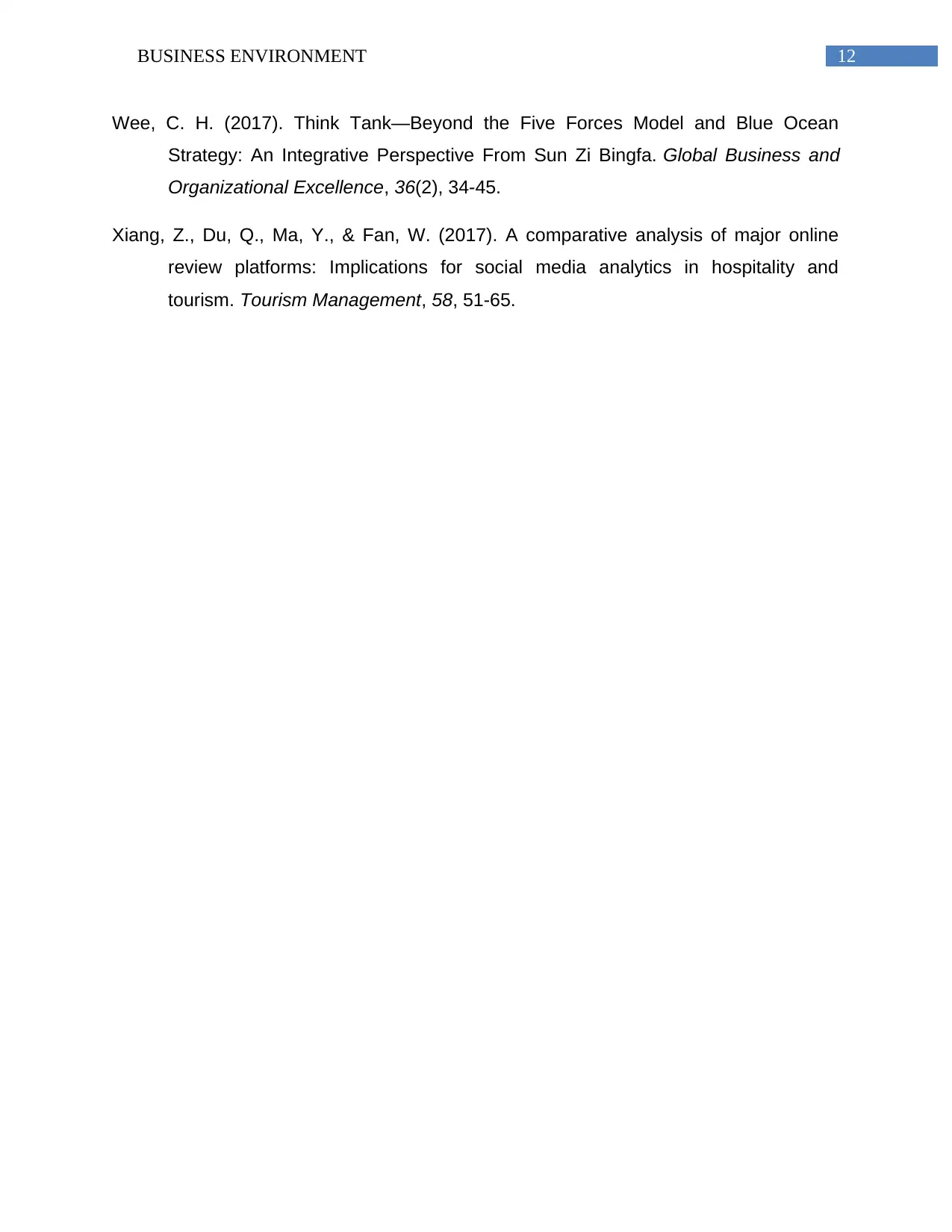
12BUSINESS ENVIRONMENT
Wee, C. H. (2017). Think Tank—Beyond the Five Forces Model and Blue Ocean
Strategy: An Integrative Perspective From Sun Zi Bingfa. Global Business and
Organizational Excellence, 36(2), 34-45.
Xiang, Z., Du, Q., Ma, Y., & Fan, W. (2017). A comparative analysis of major online
review platforms: Implications for social media analytics in hospitality and
tourism. Tourism Management, 58, 51-65.
Wee, C. H. (2017). Think Tank—Beyond the Five Forces Model and Blue Ocean
Strategy: An Integrative Perspective From Sun Zi Bingfa. Global Business and
Organizational Excellence, 36(2), 34-45.
Xiang, Z., Du, Q., Ma, Y., & Fan, W. (2017). A comparative analysis of major online
review platforms: Implications for social media analytics in hospitality and
tourism. Tourism Management, 58, 51-65.
⊘ This is a preview!⊘
Do you want full access?
Subscribe today to unlock all pages.

Trusted by 1+ million students worldwide
1 out of 19
Related Documents
Your All-in-One AI-Powered Toolkit for Academic Success.
+13062052269
info@desklib.com
Available 24*7 on WhatsApp / Email
![[object Object]](/_next/static/media/star-bottom.7253800d.svg)
Unlock your academic potential
Copyright © 2020–2025 A2Z Services. All Rights Reserved. Developed and managed by ZUCOL.





